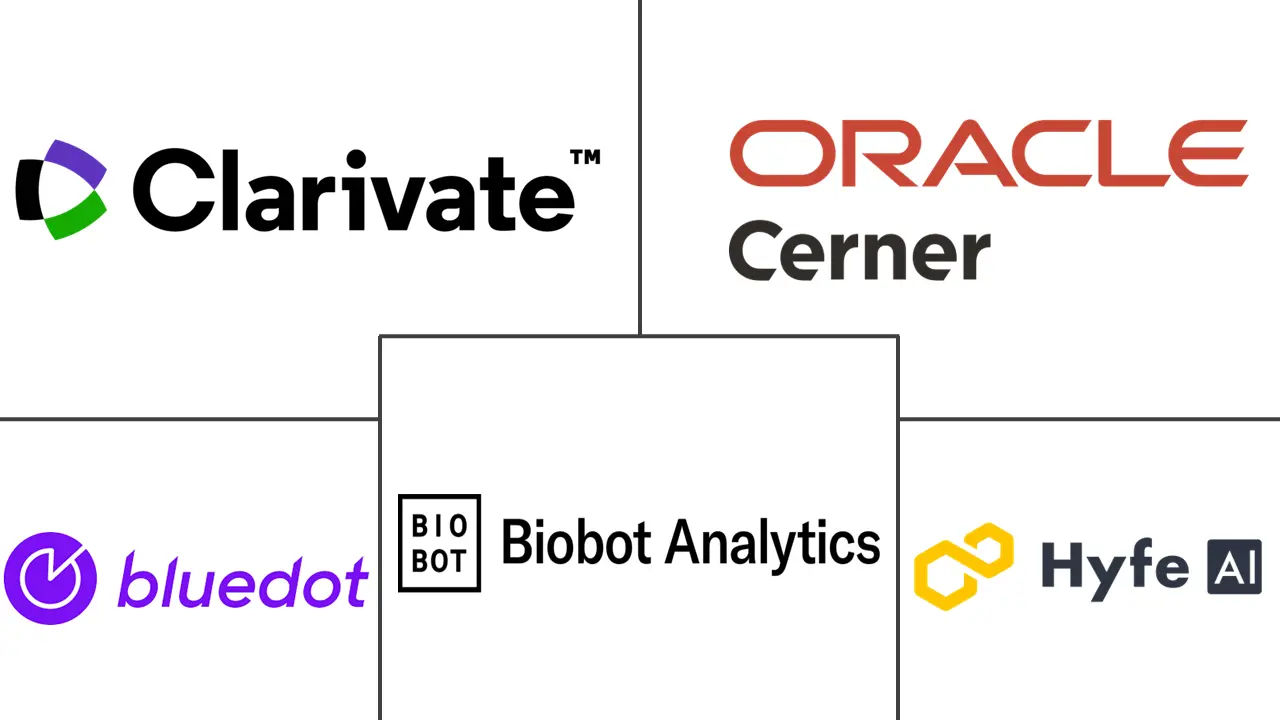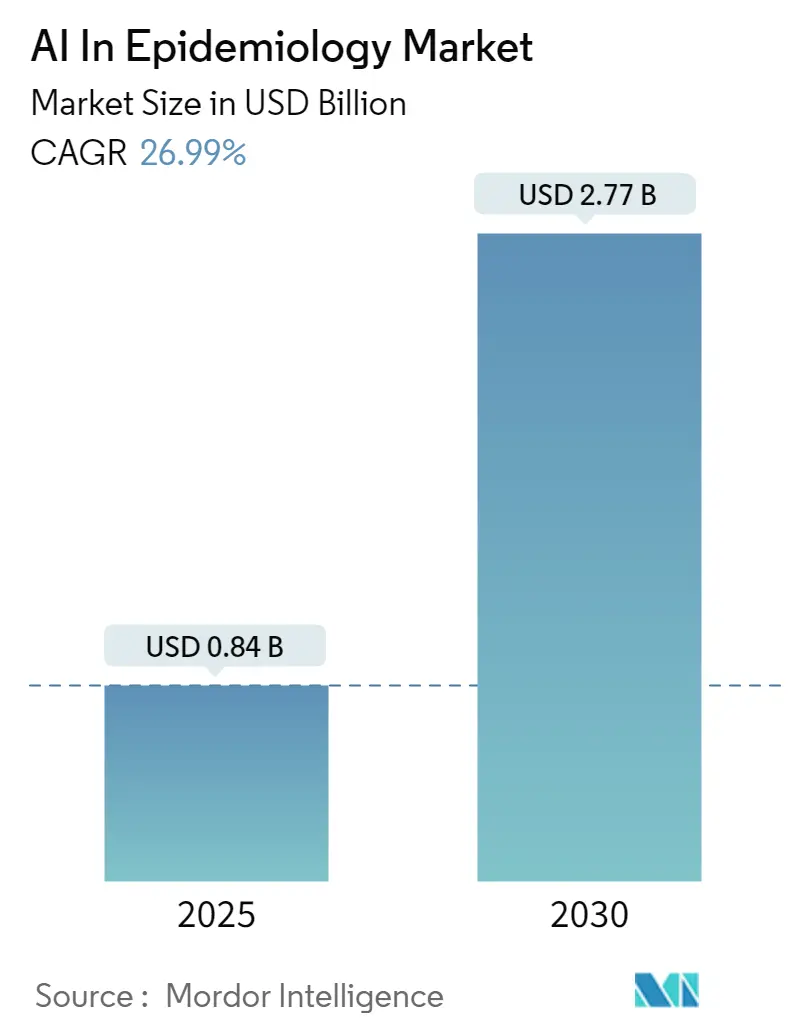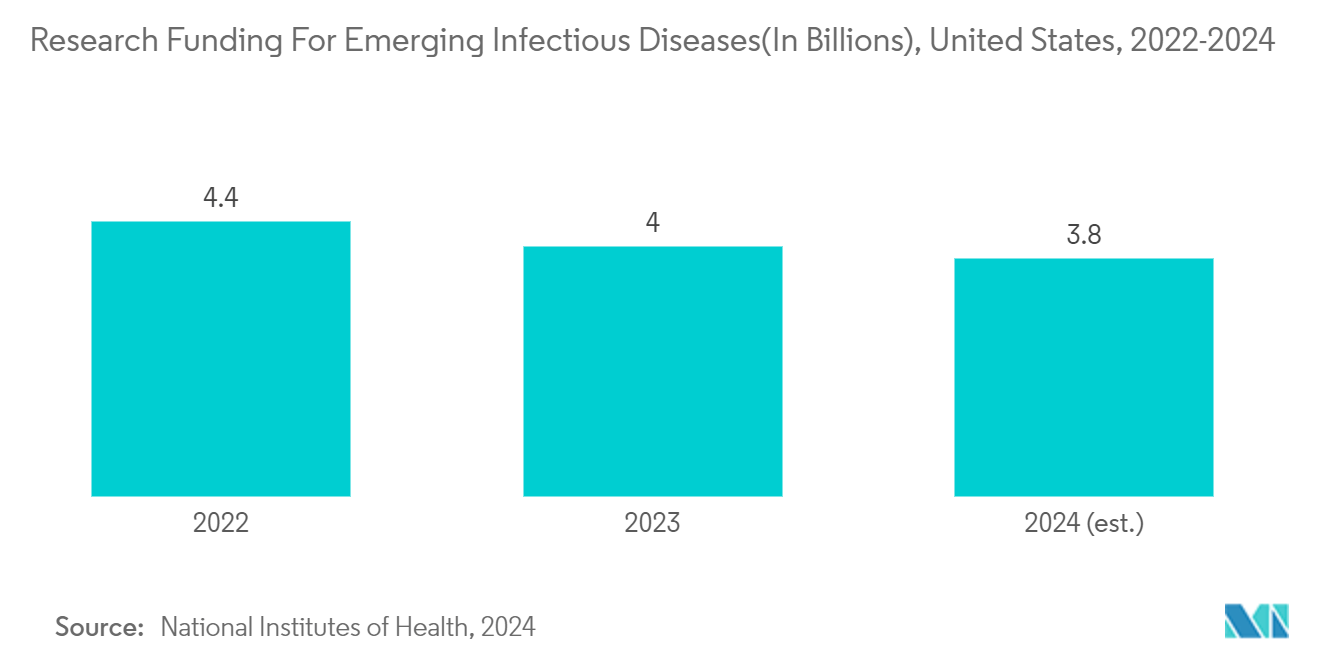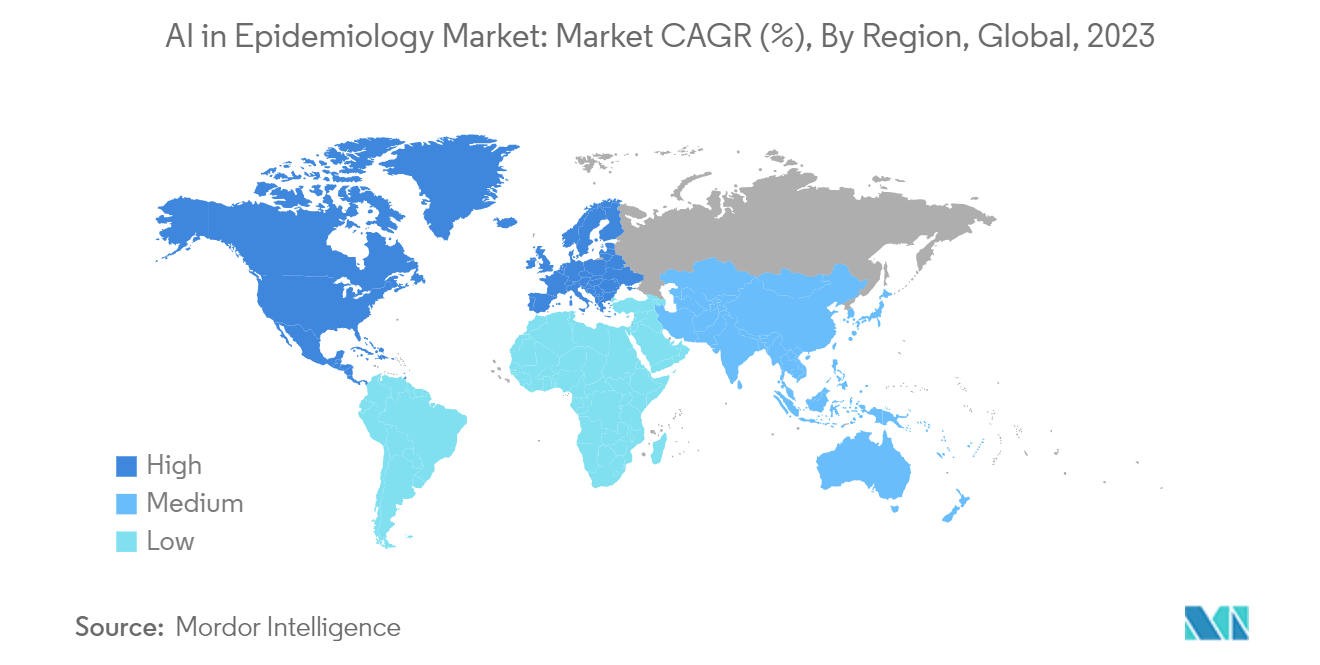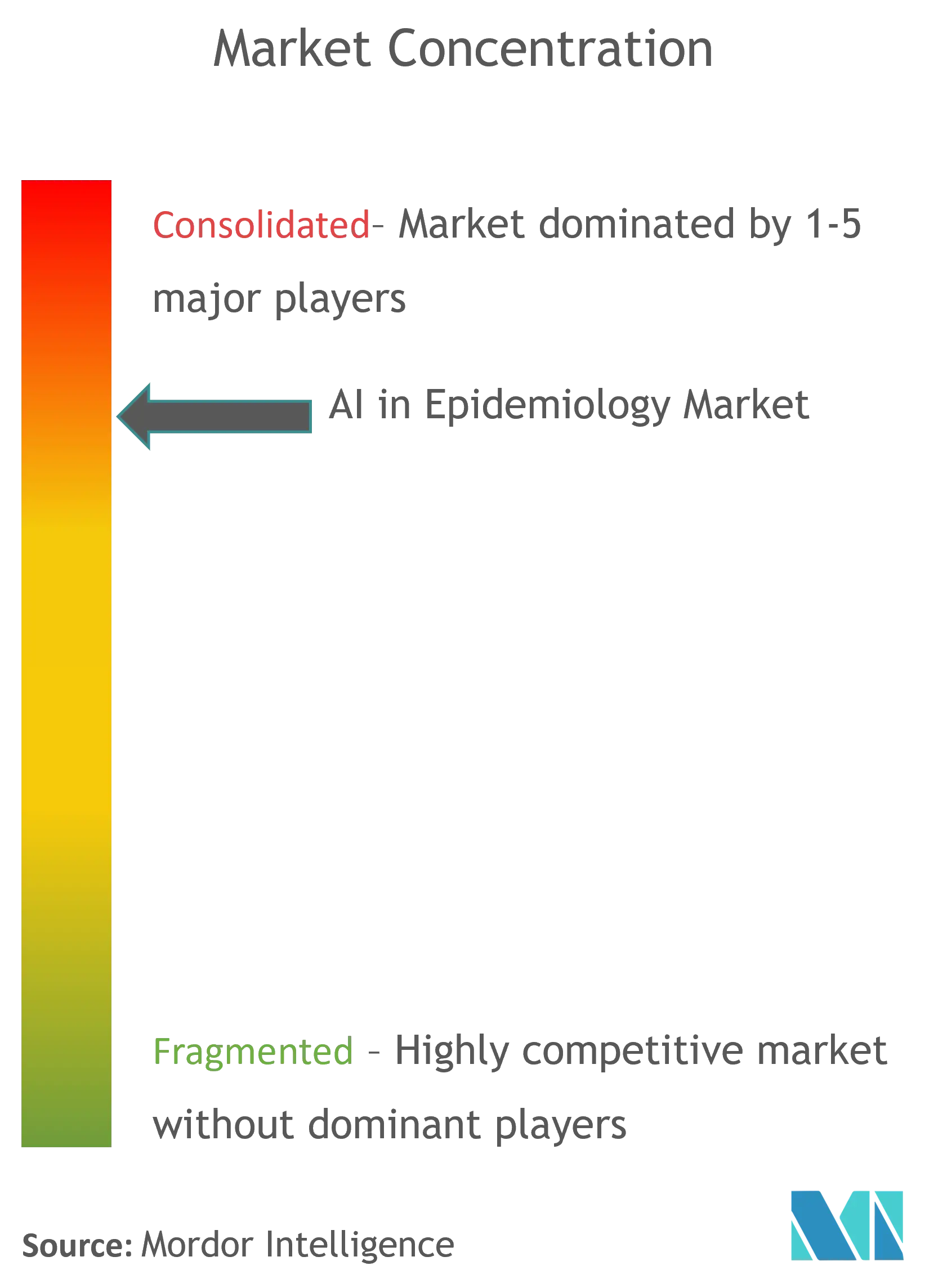AI In Epidemiology Market Analysis
The AI In Epidemiology Market size is estimated at USD 0.84 billion in 2025, and is expected to reach USD 2.77 billion by 2030, at a CAGR of 26.99% during the forecast period (2025-2030).
The major factors driving the market are the increasing technology advancements in epidemiology, increasing investment in research and development, the growing prevalence of chronic diseases along with the rising geriatric population, clinical advantages offered by artificial intelligence in epidemiology studies, and increasing government initiatives to improve the adoption of AI in epidemiology studies.
The increasing technological advancements in epidemiology are expected to optimize disease surveillance to plan and evaluate strategies to prevent illness and as a guide to managing patients in whom the disease has already developed, driving the market over the forecast period. For instance, in May 2024, SORA Technology and the Institute Pasteur du Cambodge (IPC) collaborated to launch AI for infectious disease control. This project includes a digital surveillance system for infectious diseases transmitted by mosquitoes in Cambodia, using drones and AI to detect and monitor the habitats of the larvae. The launch of such technologically advanced projects for the more effective surveillance of infectious diseases is expected to increase the demand for artificial intelligence in epidemiology studies, driving market growth over the forecast period.
Clinical advantages offered by artificial intelligence in epidemiology studies are also expected to increase the utilization of AI technologies in disease surveillance, driving market growth over the forecast period. For instance, according to an article published in the Vaccines Journal in July 2023, AI offers a significant advantage over traditional disease surveillance methods due to its ability to predict future outbreaks, empowering public health officials to take proactive and preventive measures at an early stage. Moreover, AI-based systems dynamically learn from new data, continuously improving their predictive accuracy, thereby enhancing the effectiveness of disease surveillance. Hence, the clinical advantages offered by artificial intelligence in epidemiology are expected to drive the market’s growth over the forecast period.
Increasing investments in developing AI solutions that can be used in epidemiology studies are also expected to boost the market’s growth over the forecast period. For instance, in May 2022, Epiwatch, an AI epidemic surveillance service based at UNSW Australia, received a more than USD 5 million grant from Vitalik Buterin, the co-founder of the cryptocurrency Ethereum. Such investments are expected to increase the adoption of artificial intelligence in epidemiology studies, which will ultimately drive market growth over the forecast period.
Thus, the increasing technological advancements in epidemiology, growing clinical advantages of AI in epidemiology, and increasing investments in the development of new AI technologies that can used in disease surveillance are expected to drive market growth during the forecast period. However, security concerns about patient data are expected to restrain market growth.
AI In Epidemiology Market Trends
The Disease and Syndromic Surveillance Segment is Expected to Hold a Significant Market Share Over the Forecast Period
Disease surveillance data serves as the basis for the detection of potential outbreaks for an early warning system to prevent what could become public health emergencies. Syndromic surveillance focuses on the early symptom (prodrome) period before clinical or laboratory confirmation of a particular disease. In this surveillance, information about patients' symptoms (e.g., cough, fever, or shortness of breath) is collected during the early phases of illness.
The rising demand for the monitoring and management of infectious diseases accelerates the adoption of artificial intelligence technologies to effectively track infectious diseases and prevent pandemics, which is expected to drive the segment’s growth over the forecast period. For instance, according to an article published in the Lancet Infectious Disease Journal in September 2024, Africa reports more than 160 disease outbreaks annually. To tackle this outbreak's early stage, AI-driven machine learning can be deployed to identify patterns in epidemiological, genomic, human mobility, and environmental data to detect emerging diseases and enable timely public health responses. Hence, the increasing number of infectious disease outbreaks increases the demand for AI solutions for effective disease and symptom surveillance, which is expected to drive the segment’s growth over the forecast period.
Increasing research and development activities for the development of new AI tools for disease and symptom surveillance are expected to boost the segment’s growth. For instance, in January 2024, researchers at the University of California San Diego School of Medicine utilized an artificial intelligence (AI) model, entitled COMPOSER, to quickly track the patients at risk for sepsis infection. Hence, the development of such artificial intelligence algorithms is expected to increase the adoption of AI in monitoring various diseases.
Hence, the rising demand for the monitoring and management of infectious diseases and increasing research activities for the development of new artificial intelligence algorithms are expected to drive the segment’s growth during the forecast period.
North America is Expected to Hold a Significant Market Share Over the Forecast Period
North America holds a significant market share due to the rising prevalence of infectious diseases in the region, increasing research activities for developing AI technologies, and growing strategic activities such as acquisitions by key players.
The increasing prevalence of infectious diseases in North America increases the demand for advanced technologies, such as AI solutions, to identify and track these diseases at early stages and tackle them effectively. According to the Centers for Disease Control and Prevention's updated data from March 2024, around 8.3 thousand cases of tuberculosis were reported in the United States in 2022, and around 13 million people were living with latent TB infection. Hence, the increasing prevalence of infectious diseases in North America raises the demand for AI solutions for the effective management of diseases and decreases the burden on the healthcare system. This is expected to boost the market’s growth in the region during the forecast period.
The rise in strategic activities, such as the launch of new AI solutions in epidemiology, is also expected to drive the market’s growth over the forecast period. For instance, in August 2024, BlueDot Inc., a Candian provider of infectious disease surveillance solutions, reported the launch of BlueDot Assistant and Personalized Briefs to enable global organizations and governments to identify, anticipate, and respond to infectious disease threats on a local and global scale. BlueDot Assistant leverages Cohere and Open AI’s combined technology to provide a ChatGPT-like interface between users and BlueDot’s global health and novel datasets. Hence, the launch of technologies increases the accessibility of artificial solutions that can be used in epidemiology studies, which is expected to boost the market’s growth during the forecast period.
Therefore, the increasing prevalence of infectious diseases and rising strategic activities, such as the launch of AI solutions used in epidemiology studies, are expected to drive the market’s growth during the forecast period.
AI In Epidemiology Industry Overview
The AI in epidemiology market is consolidated due to the presence of a few start-ups and some large players. The major players in the market are adopting various strategic activities such as mergers, collaborations, and expansions to strengthen their geographical presence and expand their customer base. Some of the key players in the market include Clarivate, Oracle (Cerner Corporation), Biobot Analytics, BlueDot, and Hyfe AI.
AI In Epidemiology Market Leaders
-
Clarivate
-
Oracle (Cerner Corporation)
-
Biobot Analytics
-
BlueDot
-
Hyfe AI
- *Disclaimer: Major Players sorted in no particular order
AI In Epidemiology Market News
- June 2024: EPAM Systems Inc., a digital transformation services and product engineering company, reported the acquisition of Odysseus Data Services Inc., which offers artificial intelligence and data analytics solutions used for drug safety and efficacy epidemiological research.
- April 2023: Cerner Enviza, an Oracle company, and John Snow Labs collaborated to develop a new methodology to enhance computerized queries, or phenotyping, of digital patient data and clinical notes to support pharmacoepidemiology.
AI In Epidemiology Industry Segmentation
AI-based epidemiological surveillance is a promising approach to detecting, monitoring, and predicting the spread of diseases that employs AI technologies to analyze data from multiple sources, such as electronic health records, social media, and news articles.
The AI in the epidemiology market is segmented by deployment, application, end user, and geography. By deployment, the market is segmented into cloud-based and web-based. By application, the market is segmented into infection prediction and forecasting and disease and syndromic surveillance. By end user, the market is segmented into pharmaceutical and biotechnology companies, research institutes, government and state agencies, and healthcare providers. By geography, the market is segmented into North America, Europe, Asia-Pacific, and Rest of the World. The report offers values (USD) for all the above segments.
| By Deployment | Cloud-based | ||
| Web-based | |||
| By Application | Infection Prediction and Forecasting | ||
| Disease and Syndromic Surveillance | |||
| By End User | Pharmaceutical and Biotechnology Companies | ||
| Research Institues | |||
| Government and State Agencies | |||
| Healthcare Providers | |||
| Geography | North America | United States | |
| Canada | |||
| Mexico | |||
| Europe | Germany | ||
| United Kingdom | |||
| France | |||
| Italy | |||
| Spain | |||
| Rest of Europe | |||
| Asia-Pacific | China | ||
| Japan | |||
| India | |||
| Australia | |||
| South Korea | |||
| Rest of Asia-Pacific | |||
| Rest of the World | |||
AI In Epidemiology Market Research FAQs
How big is the AI In Epidemiology Market?
The AI In Epidemiology Market size is expected to reach USD 0.84 billion in 2025 and grow at a CAGR of 26.99% to reach USD 2.77 billion by 2030.
What is the current AI In Epidemiology Market size?
In 2025, the AI In Epidemiology Market size is expected to reach USD 0.84 billion.
Who are the key players in AI In Epidemiology Market?
Clarivate, Oracle (Cerner Corporation), Biobot Analytics, BlueDot and Hyfe AI are the major companies operating in the AI In Epidemiology Market.
Which is the fastest growing region in AI In Epidemiology Market?
Asia Pacific is estimated to grow at the highest CAGR over the forecast period (2025-2030).
Which region has the biggest share in AI In Epidemiology Market?
In 2025, the North America accounts for the largest market share in AI In Epidemiology Market.
What years does this AI In Epidemiology Market cover, and what was the market size in 2024?
In 2024, the AI In Epidemiology Market size was estimated at USD 0.61 billion. The report covers the AI In Epidemiology Market historical market size for years: 2019, 2020, 2021, 2022, 2023 and 2024. The report also forecasts the AI In Epidemiology Market size for years: 2025, 2026, 2027, 2028, 2029 and 2030.
AI In Epidemiology Industry Report
Statistics for the 2025 AI In Epidemiology market share, size and revenue growth rate, created by Mordor Intelligence™ Industry Reports. AI In Epidemiology analysis includes a market forecast outlook for 2025 to 2030 and historical overview. Get a sample of this industry analysis as a free report PDF download.

